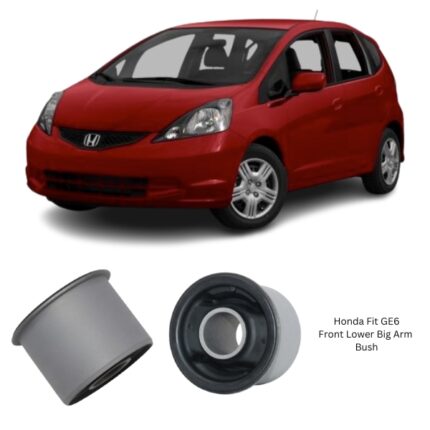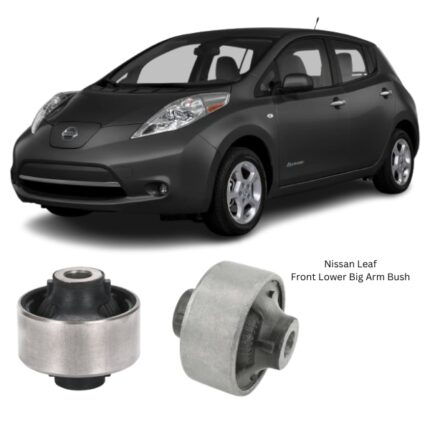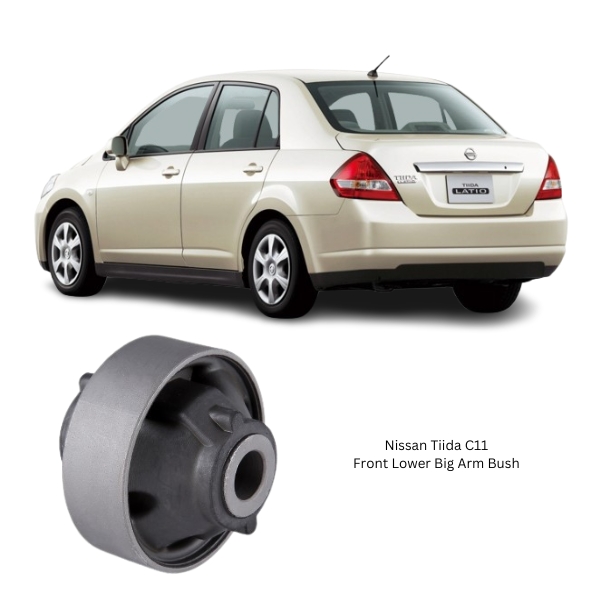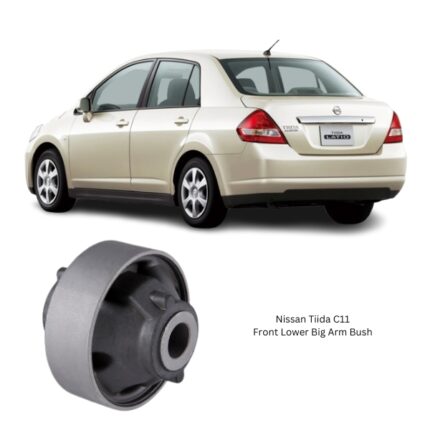Get Nissan Tiida C11 Front Lower Big Arm Bush 54570-ED50A in Kenya
The Front Lower Big Arm Bush is a foundational component within a vehicle’s front suspension system. While small and often unseen, its contribution to ride comfort, vehicle control, and suspension geometry is critical. Mounted within the large front lower control arm—commonly known as the “big arm”—this bushing serves as a pivotal link between the vehicle’s chassis and the suspension, absorbing vibrations and regulating arm movement with precision.
Its design allows for necessary movement within the control arm under road stress while also preventing unwanted play that would affect the vehicle’s alignment, handling, and braking stability. The performance of this single component directly impacts tire wear, steering accuracy, and the overall responsiveness of the suspension system.
Purpose and Function
At the heart of the front suspension lies the lower control arm, often referred to as the big arm due to its structural size and importance. The Front Lower Big Arm Bush is press-fitted into this arm and connected to the vehicle’s chassis via a bolt and bracket. It provides controlled flexibility—absorbing and managing the forces acting on the suspension system during driving.
Key Functional Roles:
-
Pivot Point for Suspension Movement
Allows the lower control arm to move vertically as the wheel responds to road undulations, keeping the vehicle stable and comfortable. -
Damping of Vibrations and Road Noise
Isolates the chassis from harsh road conditions, reducing the transmission of vibrations and noise into the cabin. -
Suspension Geometry Preservation
Maintains proper wheel alignment (toe and camber), ensuring optimal tire contact and even tire wear. -
Load Distribution
Spreads impact and dynamic loads evenly between the chassis and suspension, preventing stress concentrations. -
Steering Stability
Affects the vehicle’s handling response, especially under load, during cornering, or during emergency braking.
By managing suspension movement with elasticity and precision, the bushing enables a more refined and stable driving experience.
Design and Construction
The Front Lower Big Arm Bush is engineered to endure extreme pressure, vibration, and motion without failing. It combines flexible and rigid materials to balance comfort with structural support.
Components:
-
Outer Metal Sleeve
The outer shell, typically made of steel or aluminum, press-fits into the lower control arm bracket and holds the assembly firmly in place. -
Inner Metal Sleeve
The inner core houses the bolt that mounts the bushing to the vehicle’s subframe. It remains static during operation while the rubber flexes around it. -
Elastomeric Core (Rubber or Polyurethane)
Bonded between the inner and outer sleeves, this material absorbs road impacts, allows limited movement, and returns to its original shape. -
Directional Voids or Grooves (optional)
Some bushings feature engineered voids or patterns to enhance directional flexibility or improve stiffness characteristics under certain load angles.
Material Considerations:
-
Natural Rubber: Offers excellent flexibility and vibration dampening, commonly used for comfort and OEM applications.
-
Polyurethane (PU): Provides higher durability and performance stiffness, typically used in high-load or sport suspension systems.
The bushing must be able to resist high compressive forces and shear while flexing in a controlled manner, all without cracking, deforming, or separating from its metal sleeves.
Performance Benefits
The Front Lower Big Arm Bush directly influences key vehicle performance factors:
-
Ride Comfort
Filters out high-frequency vibrations and reduces harshness from road surface imperfections. -
Steering Control
Helps maintain the position of the suspension arms during driving, ensuring accurate steering input and feedback. -
Reduced Suspension Noise
Prevents metal-to-metal contact within the suspension system, eliminating rattles and clunks during motion. -
Improved Tire Longevity
Preserves correct wheel alignment angles, leading to more uniform and prolonged tire wear. -
Enhanced Durability
Designed to perform across thousands of compression cycles, withstanding load, heat, and contaminants. -
Consistent Suspension Geometry
Maintains chassis-to-suspension alignment over time, critical to braking efficiency and stability.
Signs of Wear or Failure
Over time, the Front Lower Big Arm Bush experiences wear due to mechanical stress, age, environmental exposure, and chemical degradation. Recognizing early signs of failure is key to preventing further damage to suspension and steering components.
Common Symptoms of a Worn Bush:
-
Clunking or Knocking Noises
Especially during acceleration, braking, or when driving over uneven surfaces. -
Unstable Steering
Increased play in the steering wheel, wandering, or vague feedback from the suspension system. -
Vibration through the Chassis or Steering Wheel
Caused by a reduction in the bush’s vibration-dampening capability. -
Uneven or Accelerated Tire Wear
Resulting from poor alignment due to excessive play in the control arm. -
Vehicle Pulling During Braking or Cornering
Indicates inconsistent suspension behavior across both sides of the vehicle. -
Visible Rubber Damage
Cracks, splits, or complete separation of the rubber from the metal sleeves on visual inspection.
Worn bushes compromise safety, comfort, and handling and should be addressed immediately.
Installation and Replacement
Replacing the Front Lower Big Arm Bush is a procedure that requires mechanical knowledge, proper tools, and precision. The process often involves removing the control arm and using a hydraulic press to remove and replace the bush.
General Installation Steps:
-
Lift and Secure the Vehicle
Raise the front of the vehicle and ensure it is securely supported. -
Remove Wheel and Related Components
Detach the wheel and any interfering components (e.g., sway bar links, lower ball joints). -
Remove Control Arm
Unbolt the control arm from the chassis and knuckle assembly. -
Press Out the Old Bush
Use a hydraulic press or bushing tool to extract the worn bushing carefully. -
Install the New Bush
Press the new bushing into the control arm, ensuring proper alignment and fit. -
Reinstall the Control Arm and Components
Bolt everything back in place and torque to manufacturer specifications. -
Perform Wheel Alignment
After suspension work, realignment is essential to restore factory steering geometry.
Professional installation is recommended to ensure proper seating and avoid damaging surrounding components.
Inspection and Maintenance
Though bushings do not require routine maintenance, they should be inspected during:
-
Suspension diagnostics
-
Brake and tire services
-
Pre-alignment checks
-
After road impact or off-road usage
-
During scheduled maintenance of the front suspension
Early detection of wear helps prevent damage to ball joints, shocks, and other suspension parts.
Follow us on Facebook for more parts.





Reviews
Clear filtersThere are no reviews yet.